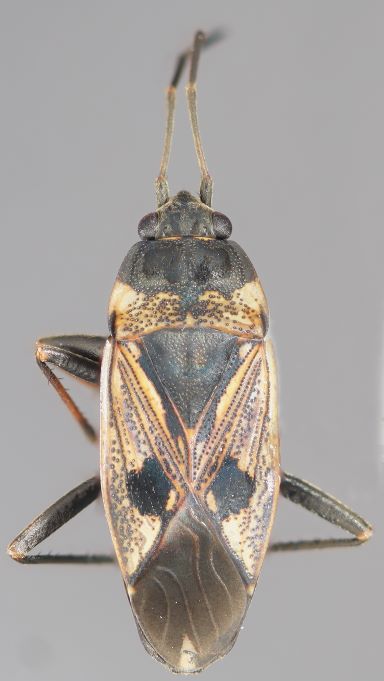Dirt Colored Seed Bugs (Raglius alboacuminatus, Rhyparochromus vulgaris, and others)
Like the boxelder bug, they like to congregate on the sunny sides of structures and can be nuisance pests.
Damage/Behavior:
They hibernate as adults in cracks and crevices and leaf litter and can reach high numbers in the home. Their size is 5-8mm. I have also had several reports from firewood. It seems they like to try to hide in firewood to spend the winter. Raglius alboacuminatus (Figure 1) is an introduced species from Europe and is established in Montana. It likes to feed on plants in the mint and figwort families (likes white mullein). It is harmless to humans and pets. Its feeding range does not appear to affect garden or house plants. Rhyparochromus vulgaris feeds on a variety of seeds. Its hosts include: Rubus spp. (blackberry), Ulmus spp. (elm), and Salvia patens (sage). It commonly occurs in forests, cleared areas, and shaded areas. It overwinters in large numbers as nymphs and adults in protected areas, e.g. under bark and in houses.

Figure 1. Raglius alboacuminatus. Photo by L. Kerzicnik
Management:
Screening or sealing cracks or other entrances into the dwelling is important. Once they have entered the home, control becomes more challenging. You can use a vacuum cleaner to get rid of the ones that have already entered your home.
Non-chemical controls:
• Install door sweeps at the base of exterior doors.
• Seal all cracks in the siding.
• One point of entry is the meeting of the foundation and siding of a building. Caulk
or fill this juncture.
• Seal utility openings where pipes and wires enter the foundation or siding.
• Avoid storing firewood next to and inside the house. Many home invaders like to
rest in firewood piles.
Chemical Controls:
As a last resort, chemical treatments can be used in the form of barrier sprays in
late summer/early fall to kill insects on the outside of the building.
• The base of doors and windows could be treated.
• Apply materials to a two- to six-foot wide band along the soil around the foundation
and two to three feet
up the foundation walls.
To learn more about the topics discussed on this page, contact the Schutter Diagnostic Lab. If you suspect an infestation on your property, contact your local extension agent, the Schutter Diagnostic Lab at Montana State University, or the Montana Department of Agriculture.
This November 2022 fact sheet is also available as a Printable PDF (178KB).
Disclaimer: These recommendations are provided only as a guide. It is always the pesticide applicator’s responsibility, by law, to read and follow all current label directions for the specific pesticide being used. The authors and Montana State University assume no liability resulting from the use of these recommendations. The Montana State University Extension Service is an ADA/EO/AA/Veteran’s Preference Employer and Provider of Educational Outreach.
